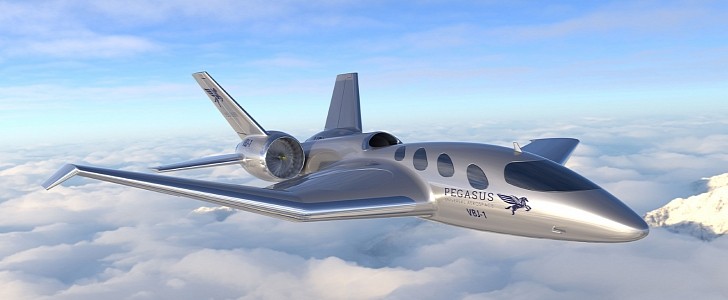One of the biggest downsides to the current development of eVTOLs is the lack of proper infrastructure, which means that, in addition to building the aircraft, companies are also developing vertiports or helipads for their use.
Johannesburg-based Pegasus is working on an aircraft that will sidestep the issue, by blending VTOL capabilities with private jet convenience. The VBJ (Vertical Business Jet) will use existing infrastructure but, at the same time, will be able to land on almost any surface, whether it’s grass or gravel, and traditional runways and helipads.
The VBJ proof of concept was showcased in September this year, with the company now working on developing a scale model for further testing. The first tests were hover tests in VTOL takeoff and landing, to demonstrate the concept’s stability. The idea is to create a private jet-like aircraft that would take off and land like a helicopter, only faster and with much less noise and vibrations, before going for forward thrust.
“The airplane uses fans in the wings to provide VTOL and then transitions to forward flight, giving it the speed, range and safety of a fixed wing airplane,” Dr. Reza Mia, founder of Pegasus, explains. “The VBJ is expected to fly at four times the speed and range of traditional helicopters and two-to-three times the speed and range of tilt-rotor VTOL airplanes.”
VTOL is possible thanks to four fans in the wings. During forward flight mode, power switches to twin double-ducted fans in the rear, and the entire process is controlled via proprietary software, which means minimal pilot intervention.
Pegasus is estimating VBJ will become available for civilian use between 2025 and 2027, but that window is, of course, largely dependent on how development and certification go. The VBJ is designed to carry up to nine passengers in private jet-like comfort, at speeds of 796 kph (495 mph) and an altitude of 10,668 meters (35,000 feet).
Depending on the takeoff and landing, range varies. In VTOL mode, it is estimated at 2,124 km (1,320 miles), while range with conventional runway takeoff and landing is double, at 4,400 km (2,743 miles). Mia says that VBJ will be less noisy than a helicopter, and 60 percent more efficient than a standard jet. He doesn’t say anything about pricing.
The VBJ proof of concept was showcased in September this year, with the company now working on developing a scale model for further testing. The first tests were hover tests in VTOL takeoff and landing, to demonstrate the concept’s stability. The idea is to create a private jet-like aircraft that would take off and land like a helicopter, only faster and with much less noise and vibrations, before going for forward thrust.
“The airplane uses fans in the wings to provide VTOL and then transitions to forward flight, giving it the speed, range and safety of a fixed wing airplane,” Dr. Reza Mia, founder of Pegasus, explains. “The VBJ is expected to fly at four times the speed and range of traditional helicopters and two-to-three times the speed and range of tilt-rotor VTOL airplanes.”
VTOL is possible thanks to four fans in the wings. During forward flight mode, power switches to twin double-ducted fans in the rear, and the entire process is controlled via proprietary software, which means minimal pilot intervention.
Pegasus is estimating VBJ will become available for civilian use between 2025 and 2027, but that window is, of course, largely dependent on how development and certification go. The VBJ is designed to carry up to nine passengers in private jet-like comfort, at speeds of 796 kph (495 mph) and an altitude of 10,668 meters (35,000 feet).
Depending on the takeoff and landing, range varies. In VTOL mode, it is estimated at 2,124 km (1,320 miles), while range with conventional runway takeoff and landing is double, at 4,400 km (2,743 miles). Mia says that VBJ will be less noisy than a helicopter, and 60 percent more efficient than a standard jet. He doesn’t say anything about pricing.











